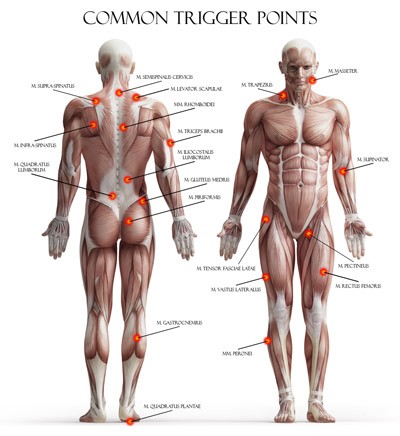Do your blue balls hurt as much as mine? SMR is torture

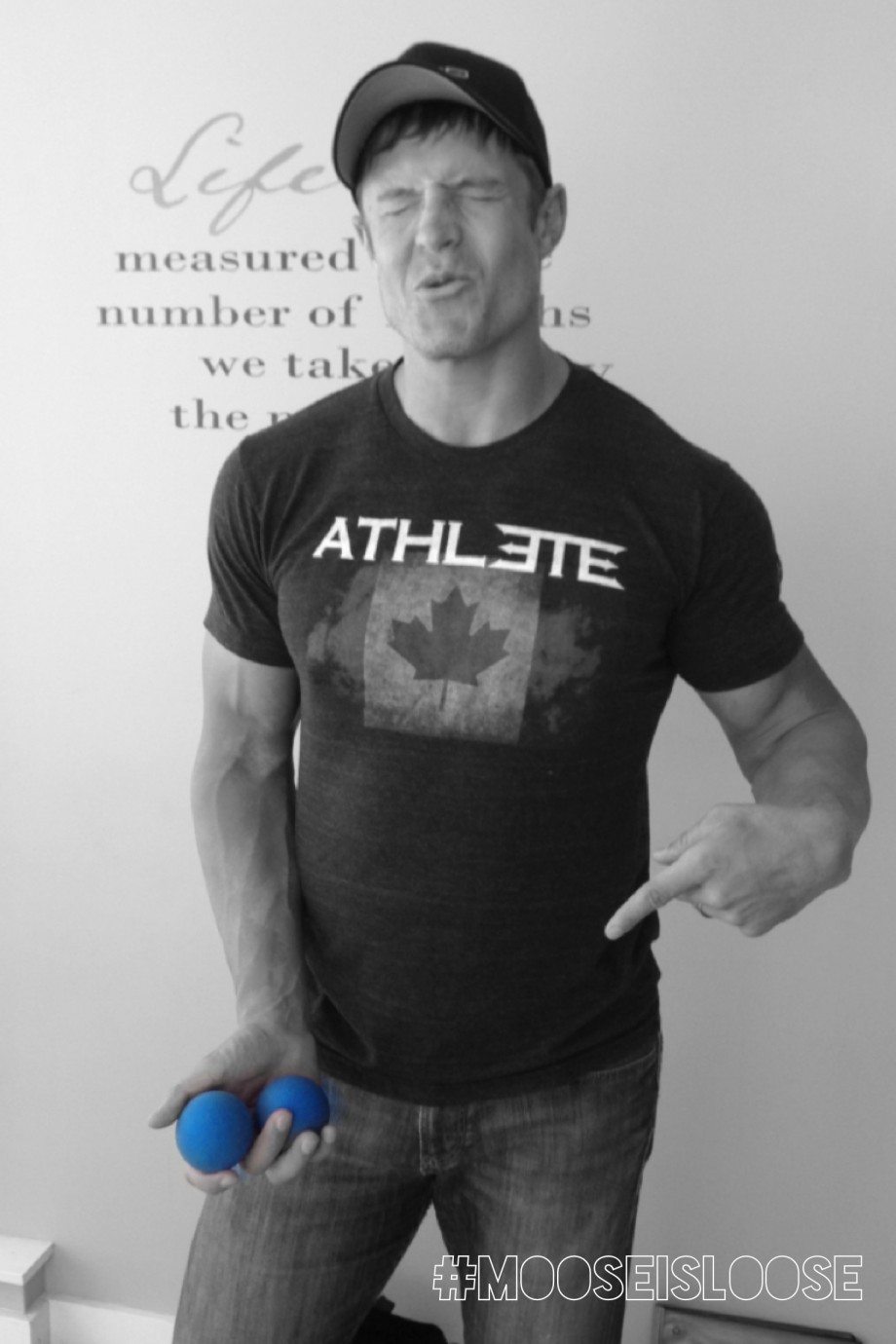 I have a love and hate relationship with blue balls
I have a love and hate relationship with blue balls
I mean why is it that they hurt so much?
Blue balls are the bane of my existence and I agonize over them for what feels like hours. I sit on them, roll on them, mash them, and lie on them until at last I FEEL IT! That magical spot where pain and pleasure meet and I hang out there a bit longer, relishing in the hot and tingly feeling of what's to come. With a massive, drawn out "Ahhhhhhhhhhhhhhhhhhhhh" I feel all tension subside. Those little, grief causing blue balls now become a source of complete, total relief, providing me a sense of satisfaction reminiscent of a big sneeze or itching that itch that was just out of reach.
Wait a minute! Seriously? This is not one of THOSE posts. This is a post for men and women equally. We all have trigger points - those little spots on our bodies in between the skin and the fascia where things get all wound up. So what do we do to get un-wound? The answers: Self-myofascial release (SMR) and trigger point therapy (TPT). (yes, to some, these techniques are one step removed from torture)
Before I continue, you might find it useful to know the answers to the following questions...
[divider]
Fascia Q&A
[toggle title="What is fascia?" state="close" ]
"Fascia" is the soft tissue part of the connective tissue that provides support and protection for most structures within the human body, including muscle. Osteopathic theory proposes that this soft tissue can become restricted due to psychogenic disease, overuse, trauma, infectious agents, or inactivity, often resulting in pain, muscle tension, and corresponding diminished blood flow. Although fascia and its corresponding muscle are the main targets of myofascial release, other tissue may be addressed as well, including other connective tissue. [2]
Bottom line, Adam Vogel puts it best when he writes: "Fascia penetrates and surrounds every muscle and organ in our body. It links together muscles, and groups of muscles, from the top of our skulls (epicranial fascia) to the bottom of our feet (plantar fascia)"
[caption id="attachment_12121" align="aligncenter" width="576"]
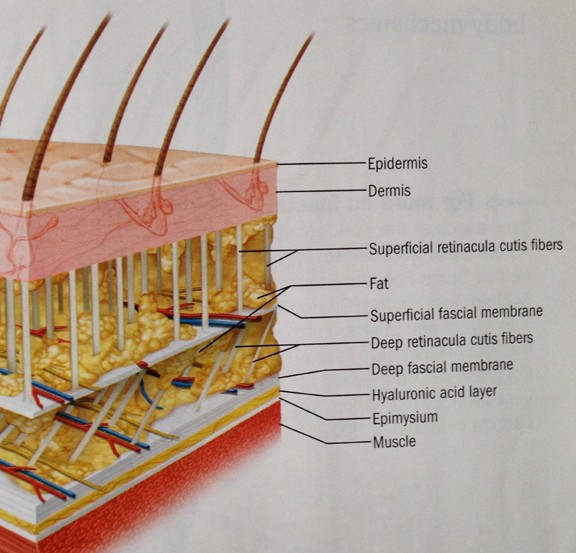 A cross-section of skin showing the different layers, including the fascia[/caption]
A cross-section of skin showing the different layers, including the fascia[/caption][/toggle]
[toggle title="What is Myofascial Release?" state="close" ]
" Myofascial release procedure is a form of soft tissue therapy used to treat somatic dysfunction and resulting pain and restriction of motion." - Wikipedia, Myofascial Release
If you were consulting a pro like a Registered Massage Therapist (R.M.T.), Active Release Technique (A.R.T.) or Rolf practitioner, they would use a variety of direct myofascial release ( or deep tissue work ) methods to engage the myofascial tissue "restrictive barrier" i.e. in layman's terms, the wound up area or tension. By using their knuckles, elbows, feet, knees and other "kneading" tools, they stretch the restricted fascia by applying force. Myofascial release is an attempt to bring about changes in the myofascial structures by stretching or elongation of fascia, or mobilizing adhesive tissues. In some instances, the pro moves slowly through the layers of fascia until the deep "wound-up" tissues are reached.
[highlight]I can speak from experience... it smarts![/highlight]
[/toggle]
[toggle title="What is a Trigger Point?" state="open" ]
Trust me, you know a trigger point when you touch one. Have you ever had a "friend" give you a massage and instead of being thankful that another human being is willing to touch you, you wince in pain as they touch certain parts of your upper shoulders or middle-to-upper back? You know what I'm talking about. Those hot spots where any touch is painful and usually cause you to leap or squirm away uncontrollably... well that's a trigger point.
Special thanks to Wikipedia for a more precise definition of a Trigger Point :
Trigger points, also known as trigger sites or muscle knots, are described as hyper-irritable spots in skeletal muscle that are associated with palpable nodules in taut bands of muscle fibers.
The trigger point model states that unexplained pain frequently radiates from these points of local tenderness to broader areas, sometimes distant from the trigger point itself. Practitioners claim to have identified reliable referred pain patterns which associate pain in one location with trigger points elsewhere. There is variation in the methodology for diagnosis of trigger points and a dearth of theory to explain how they arise and why they produce specific patterns of referred pain.
Compression of a trigger point may elicit local tenderness, referred pain, or local twitch response. The local twitch response is not the same as a muscle spasm. This is because a muscle spasm refers to the entire muscle contracting whereas the local twitch response also refers to the entire muscle but only involves a small twitch, no contraction.
[/toggle]
What causes a trigger point?
As if you even had to ask. Trigger Points are those tiny knots that develop in a muscle when it is injured or overworked ( or in my case as a CrossFitter, both ). Commonly a cause of most joint pain, they are known to cause headaches, neck and jaw pain, low back pain, tennis elbow and carpal tunnel syndrome. (source: TPTherapy.com )
[divider]
So now what? SMR & TPT to the rescue
We have trigger points and knots in our fascia that have parts of us all wound-up. We need to work them out with self massage (self-myofascial release or SMR) and TPT (trigger point therapy). By applying these techniques we can release tension in allowing the fascia to move freer. This in turn provides increased range of motion, reduction of pain, lessening of inflammation and stiffness within soft tissues, as well is ideal for post-workout recovery and maintaining overall, "good" functionality of the muscular system.
[box type="info" align="alignleft" ]
I couldn't possibly outline all the information, techniques and tools available for SMR & TPT, so instead...
My Top 3 Resources for Self-myofascial Release and Trigger Point Therapy Tools & Techniques
- Mobility WOD video library and Dr. K Starr's book " Becoming a Supple Leopard " (the bible of Mobility, need I say more?)
- Trigger Point Performance Therapy website (excellent resource for SMR/TPT tools and educational information, DVD's etc)
- TPT YouTube Channel (well over 200 videos and growing... so much great info!)
[/box]
TPT Products that I take to the gym, CrossFit box, traveling... don't leave home without them!
[one_half]
[caption id="attachment_12144" align="aligncenter" width="200"]
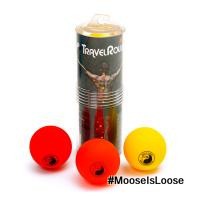 Mild to Moderate: I love this pack as it has 3 different balls, all of different densities. Mild to spicy! Travel Roller 3 variable density acupressure balls. Hard, medium, soft densities allows users to duplicate the precise work of therapists/massage.[/caption]
Mild to Moderate: I love this pack as it has 3 different balls, all of different densities. Mild to spicy! Travel Roller 3 variable density acupressure balls. Hard, medium, soft densities allows users to duplicate the precise work of therapists/massage.[/caption][/one_half]
[one_half_last]
[caption id="attachment_12155" align="aligncenter" width="280"]
 One thing you know for sure, you have choices! There's a ton of great SMR products on the market... just get one! Use it! And develop your own love hate relationship... SMR/TPT never hurt so good.[/caption]
One thing you know for sure, you have choices! There's a ton of great SMR products on the market... just get one! Use it! And develop your own love hate relationship... SMR/TPT never hurt so good.[/caption][/one_half_last]
[one_half]
[caption id="attachment_12146" align="aligncenter" width="200"]
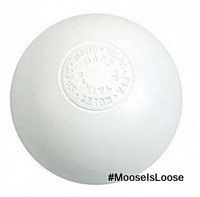 EXTRA extra SPICY! Lacrosse balls are inexpensive and a great product for SMR. Pinpoint the trigger point perfectly! Warning - very intense at times (and a bit painful)[/caption]
EXTRA extra SPICY! Lacrosse balls are inexpensive and a great product for SMR. Pinpoint the trigger point perfectly! Warning - very intense at times (and a bit painful)[/caption][/one_half]
[one_half_last]
[caption id="attachment_12147" align="aligncenter" width="200"]
 Mild: The most effective soft trigger point release ball for active adults, physiotherapists, and chiropractors. Delivers deep tissue massage for the entire body, while providing excellent grip to skin and all surfaces.[/caption]
Mild: The most effective soft trigger point release ball for active adults, physiotherapists, and chiropractors. Delivers deep tissue massage for the entire body, while providing excellent grip to skin and all surfaces.[/caption][/one_half_last]
[one_half]
[caption id="attachment_12148" align="aligncenter" width="200"]
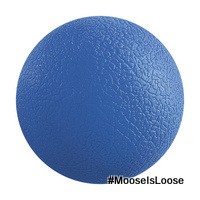 A little spicier than the purple counterpart: The most effective hard trigger point release ball. Utilizes the hardest and lightest technology, along with extreme grip, to provide very deep tissue massage for the entire body.[/caption]
A little spicier than the purple counterpart: The most effective hard trigger point release ball. Utilizes the hardest and lightest technology, along with extreme grip, to provide very deep tissue massage for the entire body.[/caption][/one_half]
[one_half_last]
[caption id="attachment_12149" align="aligncenter" width="192"]
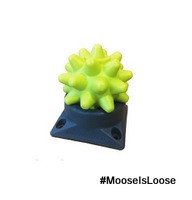 EXTRA spicy! Beastie Series massage ball by Rumble Roller is to provide more intense, versatile, portable, and affordable massage options. The Beastie is an aggressive massage ball...[/caption]
EXTRA spicy! Beastie Series massage ball by Rumble Roller is to provide more intense, versatile, portable, and affordable massage options. The Beastie is an aggressive massage ball...[/caption][/one_half_last]
[one_half]
[caption id="attachment_12150" align="aligncenter" width="200"]
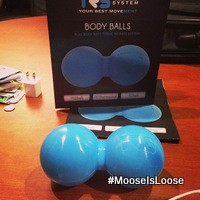 Mild to Moderate: The TRS (Tension Relief System) Activ8r delivers effective myofascial release in a package that’s versatile, portable, freezable and washable. The high-density construction and contoured design of the TRS Activ8r allows it to sink deep into the tissue achieving a true soft-tissue release, even in hard to reach places, like the mid-back, hip flexors and foot arches.[/caption]
Mild to Moderate: The TRS (Tension Relief System) Activ8r delivers effective myofascial release in a package that’s versatile, portable, freezable and washable. The high-density construction and contoured design of the TRS Activ8r allows it to sink deep into the tissue achieving a true soft-tissue release, even in hard to reach places, like the mid-back, hip flexors and foot arches.[/caption][/one_half]
[one_half_last]
[caption id="attachment_12145" align="aligncenter" width="200"]
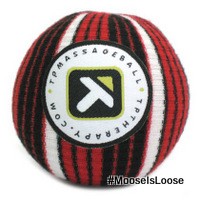 Mild to Medium: The TP Factor Ball mirrors the pressure of a forearm and provides a firm massage. This tool can be used anywhere on the body to relieve minor aches and pains by applying pressure to general areas. The Trigger Point Massage Ball is especially good for targeting the neck, shoulders, back, chest, piriformis, calves and any other hard to reach areas that require more concentrated pressure.[/caption]
Mild to Medium: The TP Factor Ball mirrors the pressure of a forearm and provides a firm massage. This tool can be used anywhere on the body to relieve minor aches and pains by applying pressure to general areas. The Trigger Point Massage Ball is especially good for targeting the neck, shoulders, back, chest, piriformis, calves and any other hard to reach areas that require more concentrated pressure.[/caption][/one_half_last]
[divider]
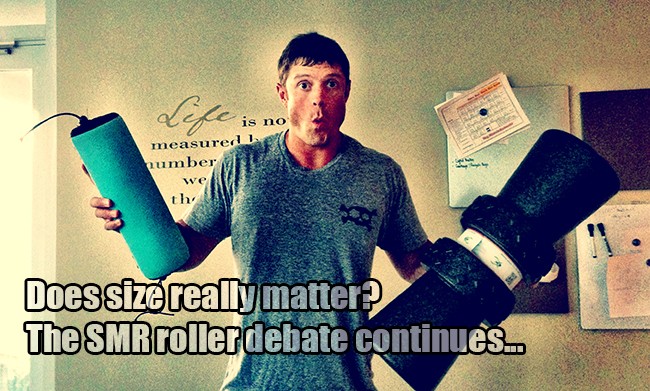
[box type="info" align="aligncenter" ]
Stay tuned for one of my future posts where I debunk the myth that
SIZE matters when it comes to which roller to choose
(You like what I did there?)
[/box]

